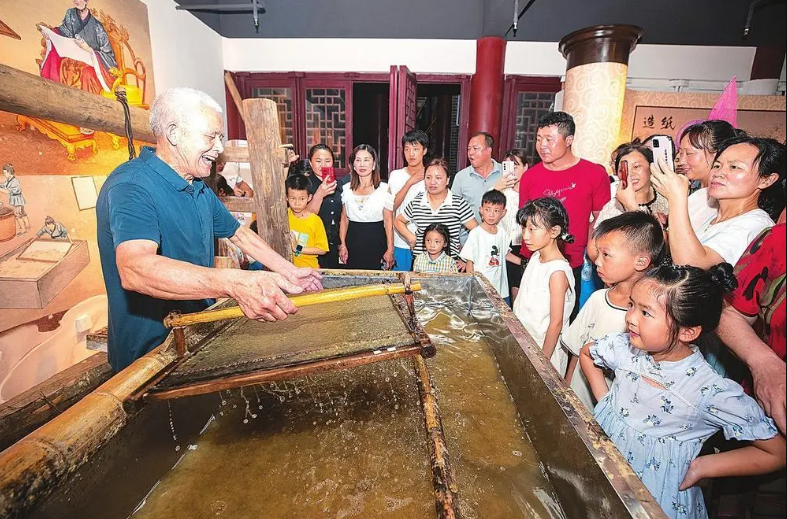Inheritance of ancient papermaking in Guiyang County
2023-08-12
Papermaking is one of the Four Great Inventions of ancient China. Cai Lun, as the inventor of papermaking, has been highly respected by people for thousands of years and revered by papermakers as the originator of paper and papermaking.
Cai Lun, whose courtesy name was Jingzhong, is a native of Guiyang, according to the records in The Eastern Han Dynasty’s “Dong Guan Han Ji” and the Southern Song Dynasty’s “Book of Later Han Dynasty”.
In Zihe Village, Baishui Yao Township, Guiyang County, Chenzhou City, there are still seven ancient papermaking workshops preserved.
Zhou Shigui, who lives in Zihe Village, was born into a family of ancient papermakers. His ancestors made paper for generations, with a history of more than 800 years. Zhou Shigui is the 27th generation inheritor of the ancient papermaking technique.

In the past, there were more than 200 households in Zihe Village, and every household made paper. Men and women, old and young, worked together. Zhou Shigui learned this craft from a young age. He hopes that this skill can be passed down and let the ancient culture shine with new vitality.
The paper made in Zihe Village is called Xiangbo paper and Maobian paper, with the ancient papermaking techniques of Cai Lun. This kind of paper mainly uses local bamboo and snowflake tree bark as the main raw materials.
After nearly 20 processes such as cutting, washing, fermentation, steaming, pounding, pulping, sheet forming, curtain shaking, and drying, a piece of paper with light bamboo fragrance can be produced.
The process of ancient papermaking is complex, and the fermentation process takes the longest time. The tender bamboo slices and snowflake tree bark are soaked in a lime water pool for more than 40 days until they are calcified.
They are then removed, washed, and sealed for about a month to ferment. After the bamboo slices are softened and peeled, they are put into the paper trough and crushed. Then, the “secret formula water” soaked with wild kiwi vines is added to enter the papermaking process.

At this point, the bamboo slices and tree bark have been crushed into pulp. After removing impurities, sheet forming, pressing and drying on racks, hand-cutting paper, drying and sun-drying, trimming and bundling, a piece of ancient paper can be put into use.
The paper produced in Zihe Village has a bright yellow color, soft and elastic texture, good water absorption and ink retention. It is widely used for writing, painting, packaging, firecrackers, and sacrificial offerings.
It was once popular in Jiahe, Lanshan, Xintian, Hengyang in Hunan, and Wuhan in Hubei Province, reaching its peak in the 1980s. With the progress of the times and the evolution of the papermaking industry, the ancient papermaking technique gradually withdrew from the market.
In recent years, Guiyang County has taken the opportunity of building research and study bases to establish ancient papermaking workshops in Guiyang Cultural Park in Hexie Village of Zhenghe Town.
A papermaking experience area has been set up, where tourists can experience the unique charm of papermaking culture by hands-on operation. This allows traditional papermaking techniques to be inherited and developed.




